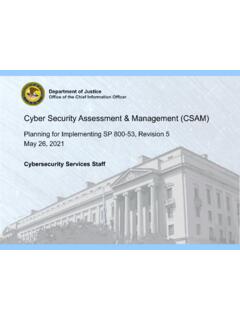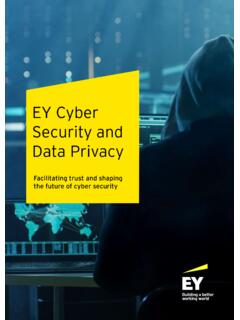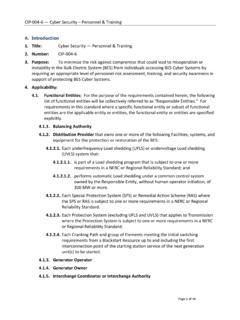Transcription of Healthcare Organization and Hospital Cyber Discussion …
1 Healthcare Organization and Hospital Discussion Guide For Cybersecurity August 2016 The Oak Ridge Institute for Science and Education (ORISE) is a Department of Energy (DOE) institute focusing on scientific initiatives to research health risks from occupational hazards, assess environmental cleanup, respond to radiation medical emergencies, support national security and emergency preparedness, and educate the next generation of scientists. This document was developed by ORISE in collaboration with the Centers for Disease Control and Prevention (CDC) Healthcare Preparedness Activity (HPA) through an interagency agreement with DOE.
2 ORISE is managed by Oak Ridge Associated Universities (ORAU) under DOE contract number DE-AC05-06OR23100. Disclaimer: The findings and conclusions in this document are those of the authors and do not necessarily represent the official position of the Centers for Disease Control and Prevention. Healthcare Organization and Hospital Discussion Guide For Cybersecurity Table of Contents iii ACKNOWLEDGMENTS The Centers for Disease Control and Prevention (CDC) Healthcare Preparedness Activity (HPA) staff would like to thank all of the organizations that helped with the development or review of this tool.
3 Subject Matter Experts Department of Health and Human Services Centers for Disease Control and Prevention Office of Public Health Preparedness and Response Division of State and Local Readiness Healthcare Preparedness Activity The following personnel from CDC-HPA contributed to this tool: Amy Valderrama Sherline Lee Dahna Batts Kelly Dickinson John Donohue* Sabrina Harper Deborah Levy* Jean Randolph Office of the Chief Information Officer Office of the Chief Information Security Officer Office of the Chief Operating Officer Office of the Chief Information Officer *Former HPA staff Healthcare Organization and Hospital Discussion Guide For Cybersecurity Table of Contents iv Assistant Secretary for Preparedness and Response Office of the Chief Information Officer Office of Information Security Office for Civil Rights Office of Emergency Management
4 Critical Infrastructure Protection Office of the National Coordinator for Health Information Technology Office of the Chief Privacy Officer Reviewers ABS Consulting Information System Security Manager Oak Ridge Associated Universities Information Systems Security Manager Administrative Support Oak Ridge Associated Universities Health, Energy, and Environment Program Health Preparedness Group The following personnel from the Oak Ridge Associated Universities (ORAU) Oak Ridge Institute for Science and Education (ORISE) contributed to this tool: Linda Hodges Healthcare Organization and Hospital Discussion Guide For Cybersecurity Table of Contents v Table of Contents ACKNOWLEDGMENTS.
5 III OVERVIEW ..1 Objectives .. 3 Benefits .. 3 Format .. 3 Recordkeeping .. 4 Homeland Security Exercise and Evaluation Program (HSEEP) .. 5 Providing Feedback .. 5 FACILITATOR GUIDE ..7 SCENARIO ..11 Instructions .. 11 Background .. 11 Discussion QUESTIONS ..13 I. Response Capabilities .. 13 Scenario Update 1 .. 13 Scenario Update 2 .. 14 Scenario Update 3 .. 15 Scenario Update 4 .. 15 Scenario Update 5 .. 16 Scenario Update 6 .. 17 Scenario Update 7 .. 18 Scenario Update 8 .. 18 Healthcare Organization and Hospital Discussion Guide For Cybersecurity Table of Contents vi Scenario Update 9.
6 19 Scenario Update 10 .. 20 Scenario Update 11 .. 21 Scenario Update 12 .. 21 II. Communication and Information Sharing .. 22 Scenario Update 13 .. 22 Scenario Update 14 .. 23 Scenario Update 15 .. 23 Scenario Update 16 .. 24 III. Prevention planning .. 25 NEXT STEPS ..27 CONCLUSION ..29 Healthcare Organization and Hospital Discussion Guide For Cybersecurity Overview 1 OVERVIEW Cybersecurity is the body of technologies, processes, and practices designed to protect networks, computers, programs, and data from attack, damage, or unauthorized access. planning for a breach in or attack on an Organization 's cybersecurity is becoming an increasingly important topic and challenge for Healthcare organizations and hospitals that rely heavily on technology for disease prevention and emergency response as well as for support and improvement of patient care.
7 This reliance on technology puts them at increased risk for opportunistic threat actors/adversaries ( , hackers) and targeted breaches or attacks. One of the most problematic elements of cybersecurity is the quickly and constantly evolving nature of security risks. The traditional approach has been to focus resources on the crucial system components and protect against the biggest known threats, which necessitates leaving some less important system components undefended and some less dangerous risks unprotected. Such an approach is insufficient in the current environment.
8 Healthcare Organization and Hospital computer systems can be attacked by hackers to steal or manipulate patients' financial or medical records or other information, and then be used for criminal activity or to create disorder and generate fear. Cyber attacks threaten Healthcare organizations and hospitals' information technology (IT), i ts underlying security measures, and their employees' ability to care for patients and respond to emergencies. Risks can include the loss of patient information, disruption of care because of software unavailability, loss of confidence in providers because of the perception of inadequate security, power outages, destruction of generators, and risks to the operational integrity of personal medical devices ( , implantable cardioverter defibrillators, pacemakers, insulin pumps).
9 In recent years, Healthcare organizations and hospitals have increased the use of wireless, personal medical devices and network connections, which places these devices at risk for privacy and security breaches. For example, these wireless devices and network connections can be enabled and modified remotely. Ensuring cybersecurity requires coordinated efforts throughout an IT system. To deal with the current environment, advisory organizations are promoting a more proactive and adaptive approach. The National Institute of Standards and Technology (NIST), for example, recently issued updated guidelines in its risk assessment framework1 that recommended a shift toward continuous monitoring and real-time assessments.
10 1 National Institute of Standards and Technology, Framework for Improving Critical Infrastructure Cybersecurity Healthcare Organization and Hospital Discussion Guide For Cybersecurity Overview 2 Healthcare organizations and hospitals can prepare for Cyber breaches or attacks by implementing measures to secure important systems that have the potential to be threatened. Cybersecurity preparedness involves adequate planning and implementation of a response process, which includes continuous research on and incorporation of lessons learned from Actual responses to Cyber breaches or attacks and other public health emergencies.
















